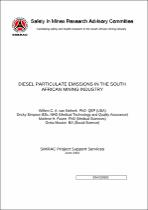JavaScript is disabled for your browser. Some features of this site may not work without it.
- ResearchSpace
- →
- Research Publications/Outputs
- →
- Conference Publications
- →
- View Item
| dc.contributor.author |
Van Niekerk, WCA

|
|
| dc.contributor.author |
Simpson, D

|
|
| dc.contributor.author |
Fourie, MH

|
|
| dc.contributor.author |
Mouton, G

|
|
| dc.date.accessioned | 2007-10-09T12:09:32Z | |
| dc.date.available | 2007-10-09T12:09:32Z | |
| dc.date.issued | 2002-06 | |
| dc.identifier.citation | Van Niekerk, WCA, et al. 2002. Diesel particulate emission in the South African mining industry. Safety In Mine Research Advisory Committee, SIM 020602, June, 2002, pp 1-49 | en |
| dc.identifier.uri | http://hdl.handle.net/10204/1301 | |
| dc.description.abstract | A large volume of scientific information is available in the open literature on the toxicology and health effects associated with inhalation of diesel particulates. It has been the intention of this study to present a concise review of the available publications with the aim of highlighting the status of knowledge and understanding in the field, to form a basis for decision-making about control of occupational exposure and institution of regulations in this regard. Assessment of sampling and analysis methods that are currently in use to quantify exposure to diesel particulates was identified as an essential step early in the study. The automotive industry generally uses gravimetric method to quantify particulate emissions. However, it is difficult to quantify particulate emissions at level in workplace air using a conventional gravimetric balance because the amounts of particulates collected on filter samples for assessment of occupational exposure is very small. A primary objective in this study has been to identify the most appropriate sampling and analytical methods and to validate the procedures. Occupational exposure surveys in selected mines were integrated with this assessment process, to establish current levels of exposure to diesel particulates. The primary outputs of the study were therefore to establish an appropriate sampling and analytical technique and to assess current levels of exposure to diesel particulates in South African mines. | en |
| dc.language.iso | en | en |
| dc.subject | SIMRAC | en |
| dc.subject | SIM 020602 | en |
| dc.subject | Diesel particulate emissions | en |
| dc.subject | South African mining industries | en |
| dc.title | Diesel particulate emission in the South African mining industry. | en |
| dc.type | Conference Presentation | en |
| dc.identifier.apacitation | Van Niekerk, W., Simpson, D., Fourie, M., & Mouton, G. (2002). Diesel particulate emission in the South African mining industry. http://hdl.handle.net/10204/1301 | en_ZA |
| dc.identifier.chicagocitation | Van Niekerk, WCA, D Simpson, MH Fourie, and G Mouton. "Diesel particulate emission in the South African mining industry." (2002): http://hdl.handle.net/10204/1301 | en_ZA |
| dc.identifier.vancouvercitation | Van Niekerk W, Simpson D, Fourie M, Mouton G, Diesel particulate emission in the South African mining industry; 2002. http://hdl.handle.net/10204/1301 . | en_ZA |
| dc.identifier.ris | TY - Conference Presentation AU - Van Niekerk, WCA AU - Simpson, D AU - Fourie, MH AU - Mouton, G AB - A large volume of scientific information is available in the open literature on the toxicology and health effects associated with inhalation of diesel particulates. It has been the intention of this study to present a concise review of the available publications with the aim of highlighting the status of knowledge and understanding in the field, to form a basis for decision-making about control of occupational exposure and institution of regulations in this regard. Assessment of sampling and analysis methods that are currently in use to quantify exposure to diesel particulates was identified as an essential step early in the study. The automotive industry generally uses gravimetric method to quantify particulate emissions. However, it is difficult to quantify particulate emissions at level in workplace air using a conventional gravimetric balance because the amounts of particulates collected on filter samples for assessment of occupational exposure is very small. A primary objective in this study has been to identify the most appropriate sampling and analytical methods and to validate the procedures. Occupational exposure surveys in selected mines were integrated with this assessment process, to establish current levels of exposure to diesel particulates. The primary outputs of the study were therefore to establish an appropriate sampling and analytical technique and to assess current levels of exposure to diesel particulates in South African mines. DA - 2002-06 DB - ResearchSpace DP - CSIR KW - SIMRAC KW - SIM 020602 KW - Diesel particulate emissions KW - South African mining industries LK - https://researchspace.csir.co.za PY - 2002 T1 - Diesel particulate emission in the South African mining industry TI - Diesel particulate emission in the South African mining industry UR - http://hdl.handle.net/10204/1301 ER - | en_ZA |






